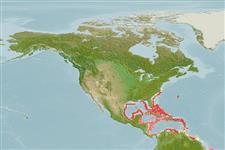Actinopterygii (ray-finned fishes) >
Anguilliformes (Eels and morays) >
Nettastomatidae (Duckbill eels)
Etymology: Nettenchelys: Greek, netta = duck + Greek, enchelys, -yos = eel (Ref. 45335); pygmaea: Named after the Greek pygmaios meaning small, dwarf, referring to the small size of the adults.
Environment / Climate / Range
Ecology
Marine; benthopelagic; depth range 128 - 280 m (Ref. 37039). Tropical, preferred ?
Western Central Atlantic: northern Gulf of Mexico and off Venezuela. Probably fairly widely distributed in the western Atlantic (Ref. 40819).
Length at first maturity / Size / Weight / Age
Maturity: Lm ?, range 15 - 20 cm
Max length : 20.1 cm TL male/unsexed; (Ref. 37039)
Short description
Morphology | Morphometrics
Vertebrae: 220 - 250. Anterior median vomerine teeth enlarged. Posterior nostril on top of head just behind posterior margin of eye. Mature at 15-20 cm TL. Other characteristics: Color brown, slightly darker dorsally than ventrally. Lateral line pores to anus number 40-42 (Ref. 37039).
Life cycle and mating behavior
Maturity | Reproduction | Spawning | Eggs | Fecundity | Larvae
McEachran, J.D. and J.D. Fechhelm, 1998. Fishes of the Gulf of Mexico. Volume 1: Myxiniformes to Gasterosteiformes. University of Texas Press, Austin. 1112p. (Ref. 37039)
IUCN Red List Status (Ref. 115185)
CITES (Ref. 94142)
Not Evaluated
Threat to humans
Harmless
Human uses
More information
Age/SizeGrowthLength-weightLength-lengthLength-frequenciesMorphometricsMorphologyLarvaeLarval dynamicsRecruitmentAbundance
ReferencesAquacultureAquaculture profileStrainsGeneticsAllele frequenciesHeritabilityDiseasesProcessingMass conversion
Tools
Can't connect to MySQL database fbquizv2. Errorcode: Too many connections
